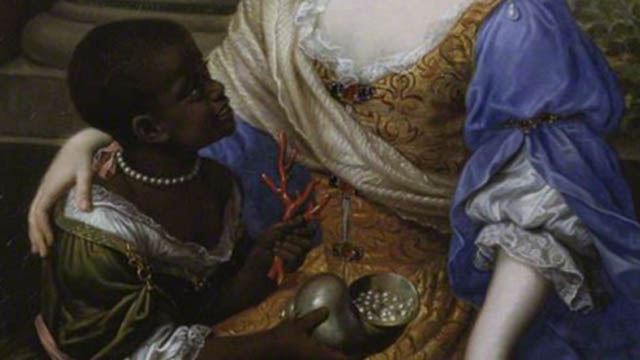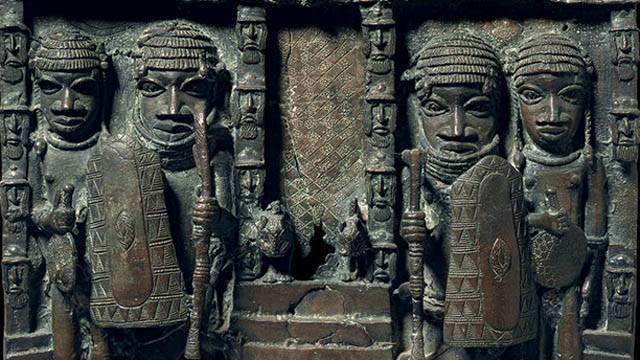In 1682 a prominent French portraitist named Pierre Mignard (1612-1695) painted a large canvas of Louise de Kéroualle, Duchess of Portsmouth (1649-1734), one of many mistresses to King Charles II of England. The artist depicts her in a richly adorned dress, sitting on an upholstered bench against the background of a stone balcony that opens to a stormy sea. With one hand Louise de Kéroualle gently embraces her page, an African child. The fashion to hold black slaves, especially children, climaxed in the late fifteenth century, but also throughout the seventeenth century slaves were present in wealthy European households as servants.
Mignard’s painting lines up with other paintings of prominent provenance featuring African pages as an attribute of wealth: Titian’s Portrait of Laura Dei Dianti from ca. 1523 and Cristovao de Morais’ Portrait of Juana of Austria from 1535-1537 both depict an Italian respectively Portugal-based noblesse in company of an equally well dressed young African page. Like the duchess Louise de Kéroualle, Duchess of Portsmouth the young female page, whose name is not conveyed, is dressed in beautiful European clothes. More peculiar however is the child's expensive pearl necklace. In the late seventeenth century pearl necklaces were a fashionable accessory for European women of extensive wealth. Imported from the Caribbean, Pacific and Indian Oceans initially by Iberian traders — later also by British and other European traders — the white, oval shaped pearls were an important trading good and symbol of prosperity and wealth. As such the valuable jewellery seems rather out of place on the neck of the page. It seems much more appropriate on the neck of the Duchess.

Fig. 1, detail
Compared to her page, the Duchess’s jewellery appears almost humble, as she wears the same pearls on small earrings. In a much higher amount, the same pearls are mirrored in a shell that the laughing child offers to her serious looking owner. In the other hand the page holds a red coral; a material that has become exceedingly valuable in many regions of West Africa. The most famous example is the kingdom of Benin (today in the region of Nigeria), where the red coral rose to a symbol of royalty and was appointed for the exclusive use of the Oba (Benin sovereign) and his household. The red coral in the hand of the African child connects the picture to the intercontinental trading network between Europe and Africa.
European merchants traded red corals from Mediterranean regions with West African traders or sovereigns in exchange for goods such as gold, ivory or slaves. In all her appearance, from her beautiful dress to her valuable attributes the representation of the African page refers to the trading network, which preceded her presence in the picture next to the Duchess. The servant acts as an attribute of wealth — well-dressed she represents the wealth of the person and house to whom she is made to belong to.
On the other side of the equator, there can be found relief works to a similar effect that allows us to further investigate the historical intercontinental trading network. Many brass reliefs, produced by the royal brass workshop in the kingdom of Benin in the 16th and 17th century, acted as attributes of economic and political power of the royal court. They represented the influence of the sovereign and the wealth of the palace where they were exhibited. A large corpus of brass plagues adorned the palace, which was the economic, religious, political and administrative centre of the kingdom of Benin. One example, currently in the collection of the anthropological Museum in Berlin, depicts two dignitaries flanked by two Omadas (palace servants) before the background of the royal palace. All of them wear pearl ruffs and headgear made of corals. Similar to Mignard’s painting, the corals also function as indicators of the far reaching diplomatic relationship of the Benin palace and symbols of the interregional economic influence of the royal household. The main trading partners to the kingdom of Benin had been Portugal and later Great Britain to whom they sold slaves, gold and ivory in exchange for brass, corals and weapons. However dissimilar the artistic technique of oil painting and brass relief might seem, in the coral they share iconographic meaning. The commodity of red corals make reference to the trading network between Europe and West Africa.

Fig. 2, detail
The trading relationships between Great Britain and Benin which were highly profitable for the rich and powerful in both kingdoms would change successively to an exploitative relationship; the final step to colonial subjugation was the British punishing expedition in 1897, which ended in the destruction of Benin and the robbery of the brass relief plaques to London, from where they were sold to institutions and private collections in Europe, the two Americas and Australia. Until today the royalty of Benin as well as the state Nigeria ask for restitution of the brass relief plaques and other works which were taken by the colonial power of Great Britain.
Peculiar about the Benin brass relief are the Portuguese heads that are engraved on the four palace columns in the background of the effigy. The Portuguese have a distinctive appearance with long straight hair and astonishingly long, pointed noses. In other reliefs the Portuguese are often depicted with Manillas, a ring in the shape of a horseshoe. The foreign metal of brass was imported to Benin by Portuguese traders. The valuable material, an alloy of copper and tin, supplemented cowrie shells as currency in the kingdom. As such the reliefs which adorned the royal palace were made of a material that circulated as money. The Portuguese merchants are depicted on a material which was an important means of their trade. Similar to the child holding the means of her enslavement in her hands, also the Portuguese heads are represented on and with the commodities which preceded their appearance in the imagery. Also British traders were depicted on brass reliefs, mostly with the attributes of armours, weapons and helmets.
At first glance the painting and the brass relief do not have much in common and a comparison seems rather pointless. One is an oil painting by one of the most famous portraitist of his time. The other was made by the prestigious royal brass workshop of the kingdom of Benin. When taking a closer look, however, one finds that both images — however different the outcome — both reveal similar means of constructing an image and its motive behind. The assets and people flanking the depicted patronages in the center of each image — on the one side the pearl necklace, red coral and the enslaved child, on the other the red corals, the manillas the Portuguese heads — build a network within the image that reflects on the economic trading network between both kingdoms. As both images were produced in the context of a royal court, and both intend to depict their far reaching trading relations, they may serve as documents to the complex histories and relations between the two kingdoms and if seen as such, may illuminate an important part of shard history that preceded the colonial era.



